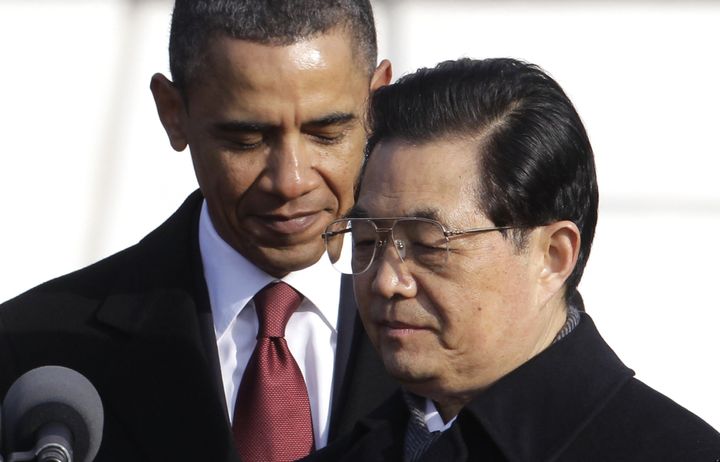
Except in the Windy City itself, where Hu Jintao heads today and will spend tomorrow, the reporting and speculative commentary on the Chinese leader's second visit to the United States has tended to focus on its just-concluding Washington leg. To me, though, the stop in Chicago seemed from the start the most potentially interesting and novel part of Hu's trip. After all, this is the first time that a visit to Chicago, an economically important crossroads city with a colorful history and famous architectural landmarks, has figured in the itinerary of the head of China's Communist Party. (UPDATE 1: a good discussion of why the Windy City makes sense as a place for Hu to be going has just appeared as the newest post at the consistently engaging and informative "Letter from China" blog maintained by former Chicago Tribune reporter turned New Yorker Beijing bureau chief Evan Osnos.)
Novelties in U.S.-China state visits, like this Chicago stop, matter in part because when a new thing takes place on one trip, a matching event often occurs during the next one. After Jiang Zemin gave a speech in 1997 at Harvard, for example, it seemed only natural that when Bill Clinton went to the PRC next, in 1998, he should give a talk at Peking University ("Beida" for short), a Beijing institution that likes to call itself the Harvard of China. So, it is worth asking this question now: What would be the most symbolically appropriate or simply most interesting Chicago-like stop that could be part of Barack Obama's schedule, if he makes another presidential trip to China?
To answer this question, I've prepared a little list of five possibilities for a second city (Beijing's got to be visited) that Obama could go to on his next trip, which would be a match for Hu's 2010 stay in America's Second City. These options range from the sensible and plausible to the intriguing but hopelessly far-fetched:
1) Chongqing. This is a booming Chinese metropolis, with a striking physical landscape due to a location on steep hills that shoot up beside the Yangzi River. One similarity to Chicago is that it has a famous and politically ambitious mayor, Bo Xilai, who, like the Windy City's latest Daley-in-charge, is the son of a famous political figure (his dad Bo Yibo took part in the Long March). Another appeal of Chongqing for a presidential visit is its historic significance for U.S.-China relations, as it was the wartime capital of Chiang Kai-shek's government back when Chinese and American armies were allied in the fight against Japan. The city's even sometimes referred to as "Chicago on the Yangtze"--the title of a smart recent article by Christina Larson (it's subtitle: "Welcome to Chongqing, the biggest city you've never heard of"--a bit misleading as there are big cities, including the next two on my list, that are probably a good deal less well known in the U.S. than Chongqing, even if some Americans are more likely to recognize the place name when rendered the old way as "Chungking").
(UPDATE 2: a good slide show focusing on variation among Chinese cities went up at the PBS Newshour site this afternoon; it has a striking image of Chongqing and shots of 3 of the 4 other urban centers on this list as well.)
2) Wuhan. This city is far down the Yangzi (Yangtze) from Chongqing, which is in China's far west. Location-wise, it's a better counterpart to Chicago, in the sense of being smack dab in the middle of a massive continent-sized country. In addition, the 1911 Revolution began with mutinies in Wuhan, and brought to power a president, Sun Yat-sen, who, like Obama, was fond of quoting Abraham Lincoln and spent part of his youth going to school in Hawaii. Downsides include the weather (at least for a summer Summit: it's called one of China's "furnace" cites for a reason) and the lack of either knock-out physical scenery (a la Chongqing) or world class buildings (another appealing option for photo ops).
3) Dongguan. Here, we move into still less probable territory, for this overgrown factory town in the Pearl River Delta is not linked to any famous moment in Chinese history or the history of U.S.-China relation. Nor does it register as an important metropolis in the internal politics of the Chinese Communist Party, contain any well-known architectural landmarks suitable for photo ops or sightseeing, or have a famous mayor. Donguan is, however, a metropolis where many of the goods bound for American big box stores are made, and so there's a match to the Chicago stopover by Hu including a focus on expanding economic ties between the two countries. In addition, a particularly interesting and powerful book on Dongguan, Leslie T. Chang's Factory Girls: From Village to City in a Changing China brings up a Chicago parallel. Chang writes that the young women she interviewed often had life stories that reminded her of those of the heroines in Theodore Dreisser novels. And the eponymous protagonist of Dreisser's best known work of fiction, Sister Carrie, traced the trials and tribulations of a country girl who became a working woman in Chicago.
4) Lhasa. This is the most outlandish idea of all, but Tibet's most famous city would in some ways be best match of all for a place Obama could go next time he was in the PRC, simply to return the favor that Hu has done him by going the American city that played the central role in his own early political career. For in the 1980s, while Obama was cutting his teeth politically as a community organizer in Chicago, Hu began his ascent to the top ranks of the Chinese Communist Party as a Beijing's representative in Tibet. Of course, what he was involved in was very different from community organizing, as his most important act in Tibet was to spearhead the harsh repressive campaign that "restored order" there after protests broke out in Lhasa and other Tibetan cities in 1989, not long before the start of the demonstrations in Tiananmen Square that captured the attention of television viewers around the world.
5. Shanghai. This final possibility doesn't pose the kind of political problem that Lhasa does. And like Chicago, it's got links to a World's Fair (since the 2010 Expo was just held there), has striking neo-classical buildings built early in the 1900s, and is associated with a notorious gangster of the last century (Shanghai's "Big Eared Du" is as well known in China as Al Capone is in the U.S.).
The problem is that Obama went to Shanghai last time. Surely he wouldn't want his second visit to be a complete rerun? And as fond as I am of Shanghai, the Chinese city I've visited and written about most, I too would hate to see him return there. For news coverage of presidential travels offers an opportunity to expand the store of images that come to mind when Americans think about China, and there's a recurring tendency, despite the ramped up reporting on the PRC, for people here to underestimate how diverse and varied that country is. So, if Lhasa's too dicey, Dongguan's too new, and Wuhan's too lacking in photo op backdrops, here's hoping that Chongqing gets the nod.
* A slightly different version of this commentary, which includes a map (that shows all the cities mentioned, except, tellingly, Dongguan, the least famous metropolis on the list), appeared earlier today at the "China Beat," a UC Irvine-based blog/electronic magazine.
